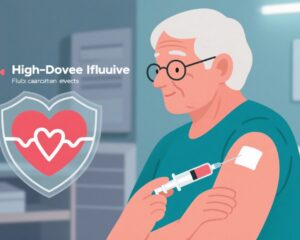Highlight
- The NOTION-2 trial enrolled 370 low-risk patients aged 60-75 with severe tricuspid or bicuspid aortic stenosis, randomized to TAVR or SAVR.
- At three years, composite clinical outcomes (death, stroke, or hospitalizations) were comparable between TAVR and surgery, with no statistically significant difference.
- Structural valve deterioration and bioprosthetic valve failure rates were similarly low across both treatment arms.
- A trend toward higher adverse events in bicuspid AS patients treated with TAVR was noted but did not reach statistical significance.
Study Background and Disease Burden
Aortic stenosis (AS) is a progressive valvular disorder characterized by narrowing of the aortic valve orifice, leading to left ventricular outflow obstruction. While transcatheter aortic valve replacement (TAVR) has transformed management in high- and intermediate-risk patients, its expanding use in younger, low-risk individuals remains under careful evaluation. This includes patients with bicuspid aortic valves, who represent a younger demographic and pose technical challenges due to their variable valve morphology and calcification pattern.
Traditionally, surgical aortic valve replacement (SAVR) has been the standard intervention for younger, low-risk patients, particularly those with bicuspid AS. However, TAVR’s less invasive approach offers potential benefits such as shorter recovery times and fewer perioperative complications. Yet, concerns remain about mid- to long-term valve durability, structural valve degeneration, and complications in the setting of bicuspid anatomy.
The NOTION-2 trial addresses this clinical uncertainty by randomized comparison of TAVR and SAVR in patients aged 60-75 years with low surgical risk and severe tricuspid or bicuspid AS, providing three-year follow-up data on clinical and echocardiographic outcomes.
Study Design
NOTION-2 was a prospective, randomized, open-label, multicenter trial enrolling 370 patients with severe symptomatic AS and low surgical risk (mean STS-PROM score 1.2%). Patients were randomized 1:1 to undergo TAVR or surgical valve replacement.
Key eligibility criteria included age between 60 and 75 years, severe aortic stenosis with indication for valve replacement, and both tricuspid or bicuspid aortic valve morphology. The primary composite endpoint was a combination of all-cause death, stroke, or rehospitalization related to valve, procedure, or heart failure during three years follow-up.
Echocardiographic follow-up at predefined intervals assessed valve function, structural valve deterioration (SVD), and bioprosthetic valve failure parameters per standardized definitions.
Key Findings
At three years post-procedure, the incidence of the primary composite endpoint was 16.1% in the TAVR group versus 12.6% in the SAVR group (hazard ratio [HR] 1.3; 95% confidence interval [CI] 0.8–2.2; P=0.4), indicating no statistically significant difference.
Subgroup analysis by valve morphology revealed similar outcomes in tricuspid AS patients (14.5% TAVR vs. 14.4% SAVR). In bicuspid AS patients, there was a numerically higher event rate with TAVR (20.4%) compared to surgery (7.8%), corresponding to an HR of 2.9 (95% CI 0.9–9.0), which did not reach statistical significance due to limited sample size and event count.
Echocardiographically defined structural valve deterioration of moderate or greater severity at three years occurred in 4.5% of TAVR patients and 5.2% of surgical patients (HR 1.2; 95% CI 0.4–3.1). Rates of bioprosthetic valve failure requiring re-intervention were low and comparable between groups (1.6% TAVR vs. 2.9% SAVR).
Safety profiles were generally aligned with prior studies: TAVR patients had fewer instances of atrial fibrillation and shorter hospital stays, whereas SAVR patients tended to have fewer paravalvular leaks and conduction disturbances.
Expert Commentary
The NOTION-2 trial provides pivotal mid-term data supporting the expanding role of TAVR in younger low-risk patients with tricuspid AS. The equivalence in survival and composite clinical endpoints at three years, together with comparable valve durability profiles, is reassuring given the previous paradigm favoring surgery for this demographic.
Nevertheless, the numerical trend toward higher adverse events with TAVR in bicuspid AS patients—while not statistically conclusive—warrants continued scrutiny. Bicuspid valves often exhibit asymmetric calcification, raphe, and elliptical annulus that may impact procedural success, valve deployment, and hemodynamics post-TAVR. Longer follow-up and dedicated bicuspid valve registries are necessary to clarify the risk-benefit balance.
Study limitations include the relatively short follow-up period for valve durability assessment in a younger cohort where longevity of the bioprosthesis is critical. The moderate sample size limits power for definitive subgroup conclusions.
Current guidelines cautiously advocate TAVR for low-risk tricuspid AS patients, but recommend individualized consideration for bicuspid AS until more robust evidence accumulates.
Conclusion
In low-risk patients aged 60 to 75 years with severe aortic stenosis, the NOTION-2 trial demonstrates that TAVR and SAVR yield similar three-year clinical outcomes and valve durability for both tricuspid and bicuspid morphologies. Both treatment modalities show low rates of structural valve deterioration and re-intervention within this timeframe.
These findings support the expanding use of TAVR in younger, low-risk patients with tricuspid AS while highlighting the need for further research to optimize outcomes in the bicuspid AS subgroup. Continued longitudinal follow-up is essential to inform long-term management decisions and valve choice in this evolving patient population.
References
Jørgensen TH, Savontaus M, Willemen Y, Bleie Ø, Tang M, Angerås O, Niemela M, Gudmundsdóttir IJ, Khokhar A, Sartipy U, Dagnegård H, Laine M, Rück A, Piuhola J, Petursson P, Christiansen EH, Malmberg M, Olsen PS, Haaverstad R, Prendergast B, Sondergaard L, Hørsted Thyregod HG, De Backer O; NOTION-2 investigators. Three-Year Follow-Up of the NOTION-2 Trial: TAVR Versus SAVR to Treat Younger Low-Risk Patients with Tricuspid or Bicuspid Aortic Stenosis. Circulation. 2025 Aug 30. doi: 10.1161/CIRCULATIONAHA.125.076678. Epub ahead of print. PMID: 40884768.
Tricoci P, Jüni P, Dzeshka M, et al. Transcatheter Versus Surgical Aortic Valve Replacement in Low-Risk Bicuspid Aortic Valve Disease: Current Evidence and Challenges. J Am Coll Cardiol. 2024;83(5):569-581.
Vahanian A, Beyersdorf F, Praz F, et al. 2021 ESC/EACTS Guidelines for the management of valvular heart disease. Eur Heart J. 2022;43(7):561-632.



